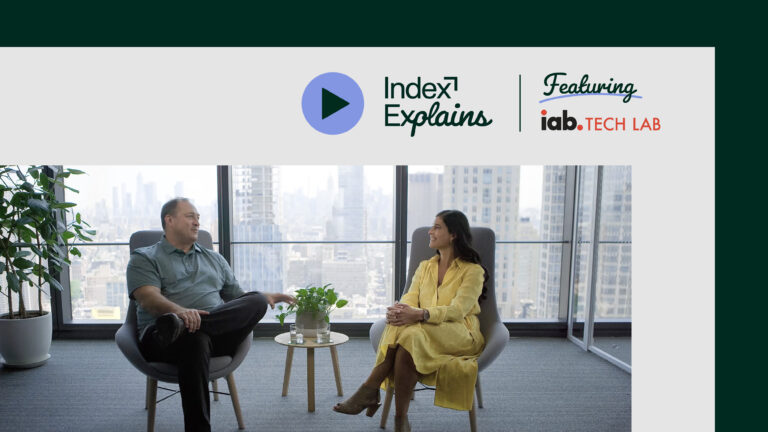Video transcript
Lori Goode: Sustainability is one of the most pressing challenges facing the ad industry today. We all have a responsibility on both a personal and business level to address climate change. Hi, I’m Lori Goode, chief marketing officer at Index Exchange, and I’m here with Brian O’Kelley, the co-founder and CEO of Scope3. We are going to talk today about how companies can accelerate their sustainability efforts in an ethical and efficient way. Brian, thank you for joining.
Brian O’Kelley: Thanks for having me.
LG: So we’re at an interesting inflection point in ad tech—consolidation, AI, cookies, urgency around sustainability—how are you thinking about the current state?
BO: Well, I think we’re in this sort of fourth generation of the digital advertising evolution, right? Starting from the nineties, we had ad networks, we had ad exchanges, we had real-time bidding, and then we had like—something. And I think we’re at the beginning of something and we’re definitely at the end of the last phase. It’s hard to know what it is. I don’t think anyone quite knows what’s beyond the next generation of AI, and what we can do with technology when we kind of have the power of language at our fingertips. Maybe everything we know about the internet just changes.
Of course, advertising responds to those changes; we don’t actually lead them. So we’re kind of waiting to see what happens. And I think companies and entrepreneurs and investors, we’re all just like, now what? Let us loose. Let’s do something big.
LG: Sustainability is something that really has emerged in our industry over the past couple of years, I would say reaching a really heightened point recently at Cannes. How can companies focus on building an ethical, efficient, and sustainable business?
BO: Well, I think those three things are all the same. So ethical, efficient, and sustainable are all actually the same conversation. For me, waste is the most obvious place to start when we talk about sustainability. So as a consumer, I don’t want to waste a bunch of single-use plastic water bottles. That saves me money. I was just adding up how much money I save by not getting a new plastic water bottle every time I go to the airport. We’re talking about tens of dollars a year. Like that’s a lot. But it adds up. And so if you think about all the inefficient things we know about programmatic advertising, every one of those steps that an ad impression takes between a publisher and an advertiser adds energy and adds cost.
So the more efficient we can make digital advertising, the more sustainable we make it. And the more we connect advertisers to content producers, the easier it is to have provenance on things like ethics. The more hops, the more chances that there’s a disconnect between where the advertiser thinks their ads are going to end up and what they’re actually paying for. So the incentives are disaligned when you have long, complex supply chains. The more we can compress those, the more we can be efficient and sustainable as an ecosystem.
LG: I’m hearing kind of two components. One around programmatic and the actual efficiency in the pipes themselves, but also around green media. So we’ll take those in two. How do you think about sustainability specifically around green media and can you walk us through some considerations for anyone who’s investing in those types of programs?
BO: Yeah, so the idea of Green Media Products is something we were playing around with last year of how could an exchange or an SSP curate the greenest media and make sure that when a buyer were to purchase a PMP or a deal ID that they’re getting only green media sources. And so we started off with some very basic ideas of don’t buy made-for-advertising inventory. Don’t buy sites that have thousands and thousands of programmatic partners. And we’ve evolved that over time. But I think this idea of the most efficient way to buy is a Green Media Product is a pretty easy concept to get your head around. We’ve seen a huge response from advertisers, from agencies who’ve said, why would we buy anything else?
I think that’s a really powerful way for the industry to move forward, is to go from once in a while we’ll buy green, to buying green by default. And partners like Index have been amazing and just saying, we’re going to do all of this across the board. It’s not going to be like there’s a little bit of our platform that’s efficient and green and good for advertisers, we’re gonna do it everywhere. I would not mind if Green Media Products were out of date someday. Because they just become how everything works. Obviously we’re still a ways from that, but I think that’s where we want to be. The default is green. The default is sustainable. The default is efficient. The default is ethical.
And then we can be creative. We can do all kinds of interesting things that we really can’t do today because we’re stuck in all of this cruft, as programmers like to say, all the junk that gets in the way of doing the work.
LG: So, I think one of the challenges that we hear a lot about, and we think a lot about, is agreeing on a standard for emissions measurement. It’s a sticking point. So basic question, what is the carbon footprint of an impression?
BO: Well, let me talk about standards for one second. Because standards, at least as I think about them, are a very precise specification for how to do something. So there’s a standard for measuring the viewability of an impression, or making sure that an ad server is accredited, or there’s this huge complicated, detailed document that says these are exactly the steps you have to go through to measure something. We don’t have that yet. There’s a lot of work going toward how we would even think about the standard. What comes before standards are frameworks, the first principles that we all agree on.
And there’s some basic questions for all of us around, what are those first principles? I’ll refer to privacy, only because it’s an interesting case where we’ve never had a problem of how. We’ve always known how to do things, but what’s the right thing to do? What’s the regulatory framework? Is privacy a human right, or is security a human right? There’s a conflict and I think there’s tension around that.
We don’t have that tension in the world of sustainability. We know that when you burn coal, a hundred grams of coal produces 200 grams of CO2. That’s an easy piece of math. And so, okay, if you have a data center and it’s powered by coal, we can do the math. If you use this much power, we produce this much carbon. Everything comes back to these basics. We call them emissions factors. If you do this, you emit this much carbon.
The hard part is allocating. The hard part is knowing, well how many of my servers were actually used to serve this ad versus how many servers were used for reporting? And what if I have a partner? What if I call out to a contextual partner, or a brand safety partner? You start getting these really complicated supply chains. And so for me, the standard isn’t where we’re struggling; it’s the incredible complexity of what it takes to actually deliver one digital ad to one person.
So the long answer to your question is the footprint of that impression is all the energy used, and every single one of the servers called in delivering that impression, plus the emissions from producing those servers, from producing those data centers, from a tiny little fraction of the travel and office space and everything else from every company that touched it. If you could just gather all of that and divide by billions of impressions, that would be the carbon footprint of an impression.
LG: Very complicated. How do we think about calculating with a consistent benchmark? How do we get there if we think about consistency across measurement?
BO: Well, everything I just said is fairly knowable. There’s a certain number of employees at Index, you have a certain amount of office space. This office building has pretty well-defined emissions. You get one floor worth of emissions; there are 80 floors. All of this could go into a spreadsheet. Where it gets complicated is when you say, okay, then we send an ad, and every ad request goes to 40 DSP partners. Well, now we need to know their information. It’s not that we can’t go find the same information, it’s just now we have to go talk to The Trade Desk and Google and Amazon. Well, wait a second, Amazon? They don’t necessarily know the answer. There’s not an easy answer. Think about all the things Amazon does. Now they have to have somebody who’s going out and saying, well, wait, what part is our publisher stuff and what part is our sponsored listings? It’s a recursive problem. Everybody has to ask their next vendor. I bet they’re hosting on Amazon Web Services. So hey, AWS team…this is the challenge.
If you look at what Scope3 does, we’ve tried to find ways to actually model the entire ecosystem, which is really hard. So we make some assumptions here and there. We’ve tried to document those in open source, but the cool thing is this consistent methodology is applicable to almost every bit of the digital media ecosystem. The question is just, how deep do you go? How accurate is every bit? But the deeper you go, the less it matters if you’re perfect. And so the estimations I think are, are getting tighter and tighter as we as an industry get better at understanding this complex supply chain.
LG: Yeah—what was directional is now honing in on something a little bit more actionable. So, we talk a lot in sustainability working groups and steering committees that we’re a part of about progress over perfection, especially in something that’s fairly early and and gaining momentum. Recognizing that we’re all on the journey together and it’s not over, and it’s far from being over, what are your thoughts on impactful versus performative actions when you think about companies and different types of efforts within these companies?
BO: There are two things I think are potentially dangerous for not just our industry, but for any industry, which is a way of saying what’s not impactful. One is the idea that we have to wait for a perfect standard before we do anything. That’s super dangerous, because there are so many things that we know we can go do today that are clearly good for the environment. Silly example, but having a thousand resellers for every ad versus having 10. Ten are better than a thousand. Is it 100 times better, or 80 times better, or 120 times better? It doesn’t matter. We know it’s dramatically better and that if you reduce the complexity of supply paths, you will have a lower footprint. I don’t think anyone’s arguing that. But if you’re waiting for someone to come up and say precisely, exactly this number—we’ve counted every carbon dioxide atom in the world, that’s too late. So that worries me.
The other thing that really worries me is targets. When people say, we are going to cut our emissions—I saw this yesterday—we’re going to cut our emissions by 20% by 2030. Well, we’re in a digital world. We don’t have factories or plants, we don’t need hydrogen pipelines. Why isn’t it going to go to almost zero by 2030? Someone else said, hey, we’ve cut our emissions from our 2018 baseline by 96%. I’m like, well, so what? Was it because you were super inefficient in 2018? Why do we care? The point is, let’s say it’s still billions and billions of tons and it’s way less than it was. Well, you still have a big problem.
So I think we need to ask ourselves the question of, what is a reasonable amount of reduction that we can do, based on what we know and what we can actually do that’s good for our business?
The last thing I’ll say is that what is impactful needs to be responsive to the business. Marc Pritchard said something like, our mission at Procter & Gamble is to grow to be superior in our categories and as sustainably as possible. And so, if it’s sustainability second, does that mean he’s not trying hard enough? Of course not. The point is, if you say we’re going to be sustainable at the cost of growth, and at the cost of being an industry leader, well that’s not going to solve anybody’s problem. Because now your competitors who aren’t as sustainable are going to win.
And so we need to remember, this is not the point of business. The point of business is to grow, to build excellent products, to delight our customers, and to do it as sustainably as possible. We are the same in media. We’re not going to compromise quality or effectiveness for sustainability. We’re going to be as sustainable as we possibly can while delivering results for our customers.
LG: I have nothing to add there. I think that’s perfect. It’s almost making sustainability—I guess I do have something to add—part of your business, actually, your core business. You need to see it as a business driver. So last question, what practical steps, as people are watching this, what actions should everyone in the supply chain take right now, and how can companies measure that progress?
BO: Well, measurement is straightforward in the sense that, we at Scope3 have a pretty great foundation for anybody in the programmatic arena. So if you’re interested in what your numbers are, we’re very happy to share with anybody where you stack up, or where you benchmark against your peers. So that’s a great place to start. If you’re a brand or an advertiser, and you want to know how you compare, we can very easily help you either directly or through many of our partners, our agency partners, brand safety partners—we have tons of folks who can help you get those numbers.
The key is to know where you stand and not to wait. And then what we always find, every time, is that there are obvious things you can do. There are resellers that aren’t adding any value to your supply chain. There are media partners who could make easy changes to reduce their carbon footprint. Just by seeing where you are, where you’re starting, you’ll find those hotspots and can make something happen. And you can do that in a way that’s positive for revenue and positive for outcomes.
We’ve yet to find a case where that’s not possible. Maybe in five years, we’re so hyper-optimized that it’ll be hard, but it’s easy right now. And so I think that’d be my advocacy: find partners like Index who are committed to this, who can help you solve those problems and spend as much money as possible with the good partners. That creates both help for you and what you’re doing, but it also shows the entire industry that the most sustainable companies are also the most profitable and effective. That’s a systemic change. Greener is better—that will completely change the world.
LG: Right. It’s the better for business part, with business operations.
BO: And better for you as a consumer. If you absolutely indicate as a consumer you’re going to buy renewable products, those companies will do well. And that tells their CEO, hey, I built sustainable shoes and I sold a lot of them. I want to build some more of those. And the competitors will walk into board meetings saying, we need a sustainability strategy. That is happening right now in this industry. There are people going, wait a second, I thought sustainability was a fad. It’s not. We need a legitimate strategy so we can go take share from our competitors.
LG: Brian, thank you so much for being here. We really appreciate it. And we’ll see you next time.
BO: Thanks for having me.
Learn more about our partnership with Scope3.



